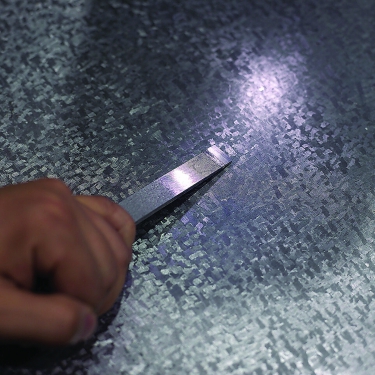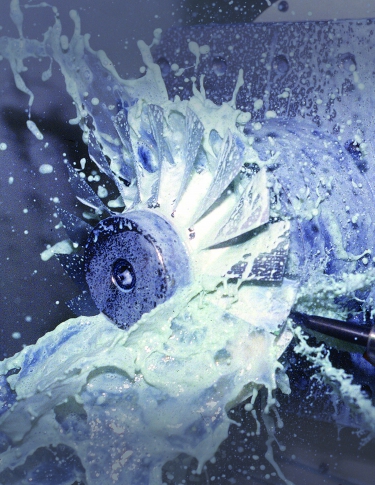When machining pricey parts for the aerospace industry, “volume” is key to delivering the required dimensional accuracy.
In this case, however, volume refers not to the number of parts manufactured in a given period of time but to the 3D space in which machining takes place.
In machining operations, the traditional way of ensuring part accuracy is to calibrate only the linear motion of the machine tools, said Robb Hudson, CEO of Mitsui Seiki (USA) Inc., Franklin Lakes, N.J. But part quality can suffer if a machine tool cannot hold tolerances uniformly everywhere in its “working envelope,” the box-shaped region that defines a machine’s 3D reach when cutting.

Hand scraping of machine tool surfaces is key to achieving high volumetric accuracy. All images courtesy of Mitsui Seiki (USA).
For high-precision machining, therefore, a determination of machine tool accuracy should be volumetric rather than linear. Hudson said the volumetric machine tool accuracy for high-precision work should be sufficient to allow moving the cutting tool center point from one known spot in the work envelope to another with no more than a few microns of positional error.
How do machine builders achieve such accuracy? Not by employing a technique commonly used for accurate positioning along a single linear axis. This technique involves compensating for small positioning errors using the CNC and some type of glass-scale or encoder feedback. But “what you cannot do is compensate for pitch, roll or yaw error in a linear axis,” Hudson said. “And when you take that pitch, roll and yaw for three independent linear axes and add them up, your volumetric accuracy begins to suffer as a result.”
Instead of error compensation, machine tool builders get the required volumetric accuracy by relying on a number of techniques and strategies that involve their manufacturing environment and methodology. One is hand scraping the surfaces on which guide ways are mounted. This laborious process is employed to ensure straightness of travel and that mating surfaces fit together precisely.
“We scrape all our machines to minimize roll, pitch and yaw error on the linear axes,” Hudson said. The process can take a week.
The technicians tasked with the job must scrape surfaces to micron-level tolerances. Their work is checked using a telescope-like device called an autocollimator, which measures the pitch and yaw of the surface. If out of spec, the surface is scraped again. Scraping and measuring are repeated until the specified tolerances are achieved.

Production of critical aerospace components, such as this blisk, requires machine tools with high volumetric accuracy.
Another key to building machines with high volumetric accuracy is effective thermal control of the manufacturing area. “We go to great lengths to control the environment where we build our machines,” Hudson said. These environments are maintained at 20° C ±0.4° C (68° F ±1.36° F) and 55 percent humidity, with no temperature difference in the vertical direction.
In addition, Mitsui Seiki makes iterative checks during the assembly process to ensure its machine tools are performing as expected. If a machine falls short during one of these checks, “you have to take it apart and redo it,” Hudson said.
A machine tool’s volumetric accuracy is determined using a probe mounted in the machine spindle. The probe measures a part whose exact dimensions were previously determined. Volumetric accuracy is then found by comparing the spindle-probe measurements to the actual part dimensions.
In addition to many aerospace parts, high volumetric accuracy is required to machine sophisticated die and mold components, Hudson said. And, he added, some in the automotive industry also need high volumetric accuracy for machining components such as valve bodies and hydraulic and steam manifolds.
You could say that a growing list of applications speaks volumes about the 3D view of accuracy and its importance in meeting some of the world’s toughest machining challenges.
Contact Details
Related Glossary Terms
- computer numerical control ( CNC)
computer numerical control ( CNC)
Microprocessor-based controller dedicated to a machine tool that permits the creation or modification of parts. Programmed numerical control activates the machine’s servos and spindle drives and controls the various machining operations. See DNC, direct numerical control; NC, numerical control.
- pitch
pitch
1. On a saw blade, the number of teeth per inch. 2. In threading, the number of threads per inch.
- work envelope
work envelope
Cube, sphere, cylinder or other physical space within which the cutting tool is capable of reaching.


